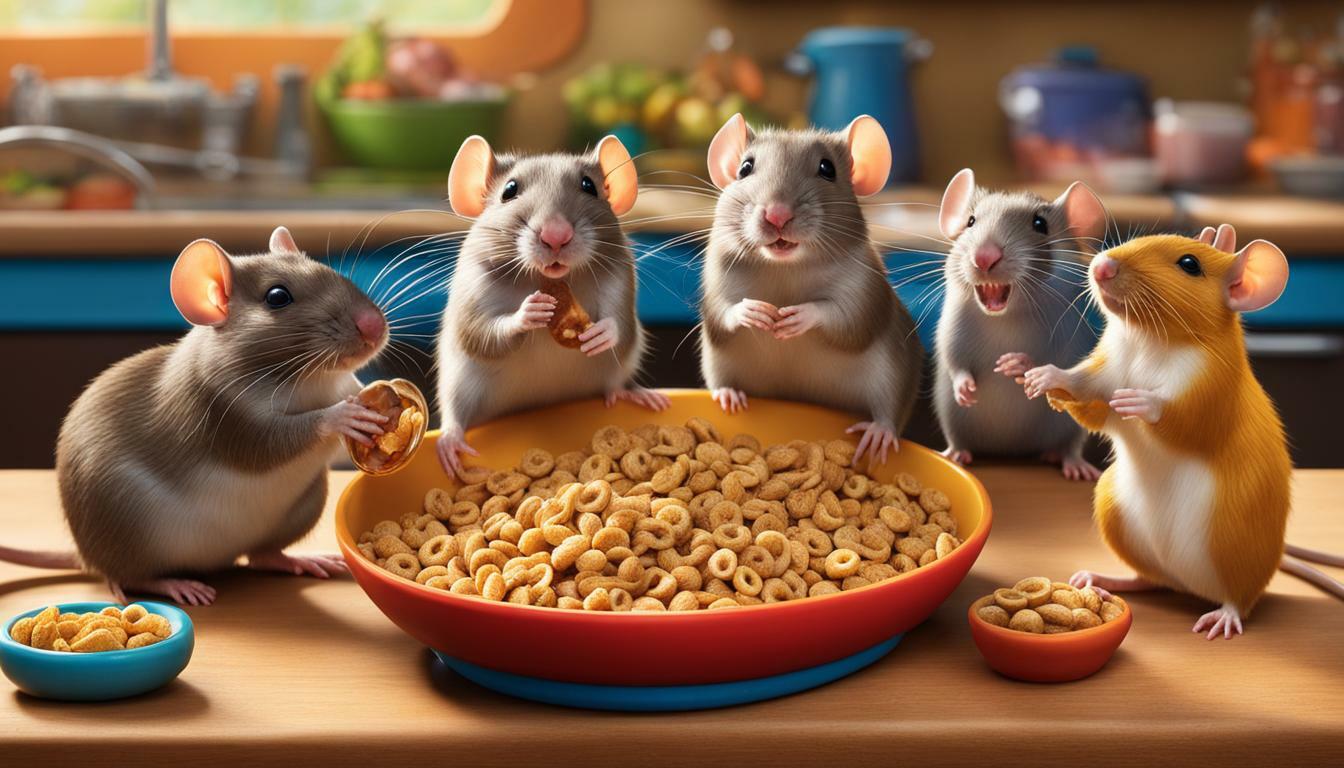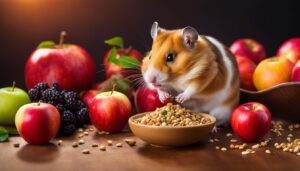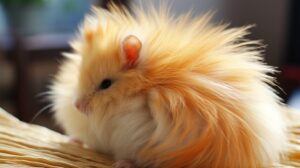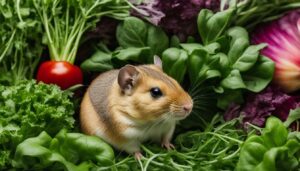If you’re wondering whether rats can enjoy a bowl of Honey Nut Cheerios, read on to discover the facts about feeding these popular cereals to your pet rats.
Key Takeaways:
- Rats can have Honey Nut Cheerios as a treat, but it should be served in moderation due to their high sugar content.
- Whole grain Cheerios are the healthiest option for rats as they contain less sugar.
- It is not advisable to serve Cheerios to rats every day or more than twice a week.
- Honey Nut Cheerios can cause diabetes in male rats due to their high sugar content.
- It is important to introduce Cheerios gradually to rats and mix them with other treats like apples, cabbage, bread, cheese, scrambled eggs, banana, or corn to make a unique treat.
- It is recommended to wait until baby rats are 9 weeks old before serving them treats.
Rat Diet – Essential Considerations
Before delving into specific foods like Honey Nut Cheerios, it’s essential to understand the overall dietary requirements of pet rats. Rats are omnivores, meaning they need a balanced mix of fruits, vegetables, grains, and protein to thrive. Providing a diverse and nutritious diet is crucial to their health and well-being.
When it comes to treats like Honey Nut Cheerios, moderation is key. While rats can enjoy this cereal as an occasional treat, it should not be a regular part of their diet. Honey Nut Cheerios contain a high amount of sugar, which can lead to weight gain and potential health issues, especially in male rats who are more prone to developing diabetes.
To offer a healthier alternative, whole grain Cheerios are a better choice. They contain less sugar and provide a good source of whole grains, which can benefit your rat’s digestive system. When introducing Cheerios to your furry friend, remember to do so gradually. Mix a small number of Cheerios with other rat-friendly treats like apples, cabbage, bread, cheese, scrambled eggs, banana, or corn to create a unique snack.
Rat Diet Recommendations:
- Offer a variety of fresh fruits and vegetables daily, such as carrots, broccoli, peas, and strawberries.
- Include high-quality rat pellets as the main source of nutrition.
- Provide lean protein sources like cooked chicken or tofu.
- Offer small amounts of healthy grains, such as cooked rice or pasta, as a source of carbohydrates.
- Ensure access to clean, fresh water at all times.
It’s important to note that treats, including Honey Nut Cheerios, should only constitute a small portion of your rat’s overall diet. Offering treats no more than twice a week is a good rule of thumb to prevent excessive sugar intake and maintain a balanced diet for your furry friend.
| Treat | Frequency | Quantity |
|---|---|---|
| Honey Nut Cheerios | No more than twice a week | Small portion mixed with other treats |
| Whole Grain Cheerios | No more than twice a week | Small portion |
| Apples | Once a week | Small slice |
| Cabbage | Once a week | A few leaves |
Lastly, it’s important to wait until baby rats are at least 9 weeks old before introducing treats like Cheerios into their diet. Young rats have different dietary requirements, and their digestive systems may not be fully developed to handle certain foods. Always consult with a veterinarian for specific dietary recommendations for baby rats.
Honey Nut Cheerios: Sugar Content and Risks
When it comes to including Honey Nut Cheerios in your rat’s diet, it’s important to be aware of the sugar content and potential risks this cereal may pose. While rats can enjoy Honey Nut Cheerios as a treat, moderation is key due to their high sugar content.
Honey Nut Cheerios are known for their sweet taste, and this is largely due to the added sugar and honey. The high sugar content can be problematic for rats, as they are prone to developing diabetes. Male rats, in particular, are at a higher risk of developing this condition when exposed to excessive amounts of sugar.
To mitigate the potential risks, it is recommended to serve Honey Nut Cheerios as an occasional treat rather than a regular part of your rat’s diet. It is not advisable to feed your rats Honey Nut Cheerios every day or more than twice a week. Instead, consider whole grain Cheerios as a healthier alternative, as they contain less sugar and provide a more balanced nutritional profile.
| Cereal | Sugar Content per Serving (1 cup) |
|---|---|
| Honey Nut Cheerios | 12g |
| Whole Grain Cheerios | 1g |
When introducing Cheerios to your rats, it is important to do so gradually. Start by offering small quantities and monitor their response. It is also a good idea to mix the Cheerios with other rat-friendly treats to make a unique snack. Some suitable options include diced apples, cabbage leaves, bread, cheese, scrambled eggs, banana, or corn.
Additionally, it is crucial to wait until baby rats are at least 9 weeks old before introducing them to treats like Honey Nut Cheerios. Their digestive systems are still developing, and their primary diet should consist of a nutritionally balanced rat food. Consult with a veterinarian for specific feeding guidelines for your pet rats.
Healthy Alternatives: Whole Grain Cheerios
Instead of Honey Nut Cheerios, consider opting for whole grain Cheerios as a healthier alternative for your pet rats. Whole grain Cheerios have a lower sugar content compared to their honey-flavored counterpart, making them a better choice for rat health. These cereal pieces are small and easily manageable for rats and can be a fun and nutritious addition to their diet.
Whole grain Cheerios provide essential nutrients like fiber, vitamins, and minerals that contribute to the overall well-being of your pet rats. They are a good source of carbohydrates, which provide energy, and contain minimal fat content, making them a suitable choice for weight management. Feeding your rats whole grain Cheerios in moderation can help promote a balanced diet and prevent the potential health risks associated with excessive sugar intake.
To create a unique snack for your rats, you can mix whole grain Cheerios with other rat-friendly treats such as small pieces of apple, cabbage, bread, cheese, scrambled eggs, banana, or corn. This combination will not only add variety to their diet but also provide additional nutrients and flavors to keep them engaged and satisfied.
The Benefits of Feeding Rats Whole Grain Cheerios
Feeding your rats whole grain Cheerios offers several benefits. Firstly, these cereals are readily available and affordable, making them a convenient option for pet owners. Secondly, the small size of the cereal allows for easy portion control to prevent overfeeding. Additionally, rats enjoy the crunchy texture of Cheerios, which can help promote dental health by keeping their teeth clean and exercised.
However, it’s important to note that whole grain Cheerios should still be served in moderation. While they are a healthier choice compared to Honey Nut Cheerios, they should not be the sole component of your rat’s diet. It is crucial to maintain a diverse and balanced diet that includes a variety of fresh fruits, vegetables, protein sources, and other rat-friendly treats to ensure your rats receive all the necessary nutrients for optimal health.
| Rat Treats | Nutritional Benefits |
|---|---|
| Apple | Provides vitamins and fiber |
| Cabbage | Offers antioxidants and support for the immune system |
| Bread | Provides carbohydrates and energy |
| Cheese | Rich in protein and calcium |
| Scrambled Eggs | Excellent source of protein |
| Banana | Offers potassium and natural sugars |
| Corn | Provides fiber and essential nutrients |
Introducing Cheerios to Rats
To ensure a smooth introduction of Cheerios to your pet rats, follow these tips for compatibility and make the experience enjoyable for both you and your furry friends.
1. Gradual Introduction: When introducing Cheerios to your rats, it’s important to start slow. Begin by offering a small amount of Cheerios mixed with their regular food. This gradual approach allows their digestive system to adjust to the new treat without causing any discomfort.
2. Mix with Rat-Friendly Treats: To make the Cheerios experience more exciting for your rats, try mixing them with other rat-friendly treats. Apples, cabbage, bread, cheese, scrambled eggs, banana, or corn can be great options. This not only adds variety to their diet but also enriches their eating experience.
3. Create a Unique Snack: Get creative and create a unique snack by combining Cheerios with other rat-safe foods. You can place the Cheerios in a puzzle toy along with some vegetables or fruits. This can stimulate their foraging instincts, providing both mental and physical stimulation.
Quotes:
“Introducing Cheerios to rats requires a gradual approach and mixing them with other treats can make it more enjoyable for your furry friends.”
| Rat-Friendly Foods to Mix with Cheerios | Benefits |
|---|---|
| Apples | Rich in vitamins and antioxidants |
| Cabbage | High in fiber and supports digestive health |
| Bread | A source of carbohydrates for energy |
| Cheese | Provides protein and calcium |
| Scrambled eggs | Protein-rich and easy to digest |
| Banana | Contains potassium and natural sugars |
| Corn | Rich in fiber and antioxidants |
Remember, while Cheerios can be a tasty and occasional treat for your pet rats, it’s important to feed them in moderation. Avoid serving Cheerios every day or more than twice a week due to their high sugar content. Stick to whole grain Cheerios as a healthier alternative. Additionally, wait until your baby rats are 9 weeks old before introducing them to treats.
Feeding Frequency and Portion Control
While it’s okay to offer Honey Nut Cheerios to your pet rats, it’s crucial to maintain an appropriate feeding frequency and control their portion sizes. Rats have small stomachs and can easily become overweight or develop health issues if they consume too much sugary cereal. Moderation is key to ensuring their well-being and overall health.
It is recommended to feed Honey Nut Cheerios to rats no more than twice a week. This allows for variety in their diet while minimizing the risks associated with excessive sugar intake. Additionally, serving Honey Nut Cheerios as an occasional treat helps maintain their nutritional balance and prevents them from becoming dependent on these cereals as a primary food source.
Portion control is equally important when offering Honey Nut Cheerios to rats. A small handful or a couple of tablespoons per serving is a suitable portion size. This ensures that they receive a treat without overindulging. Remember, rats have different dietary needs compared to humans, so it’s essential to adjust portion sizes accordingly.
Table 1: Recommended Feeding Frequency and Portion Control for Rats and Honey Nut Cheerios
| Rat Size | Feeding Frequency | Portion Size |
|---|---|---|
| Adult | Twice a week | A small handful or 2 tablespoons |
| Baby (< 9 weeks old) | Not recommended | Wait until the baby rats are 9 weeks old before introducing treats |
Remember that Honey Nut Cheerios should not be the only treat offered to your rats. They should have a varied diet consisting of fresh fruits, vegetables, and other healthy snacks. Mixing Honey Nut Cheerios with rat-friendly foods like apples, cabbage, bread, cheese, scrambled eggs, banana, or corn can create a unique snack that adds diversity to their diet.
By maintaining an appropriate feeding frequency, controlling portion sizes, and providing a balanced diet, you can ensure that your pet rats can enjoy Honey Nut Cheerios as an occasional treat while promoting their overall health and well-being.
Potential Risks: Diabetes and Male Rats
Male rats, in particular, need special attention when it comes to their diet and Honey Nut Cheerios due to the potential risk of diabetes. These cereals are known to be high in sugar, which can lead to health issues in rats if consumed in excess. Diabetes, a condition characterized by high blood sugar levels, is a concern for male rats due to their increased susceptibility.
Sugar-rich foods like Honey Nut Cheerios can significantly impact a rat’s blood sugar levels and potentially lead to insulin resistance over time. This can increase the risk of diabetes, especially in male rats. It is crucial for rat owners to be aware of this risk and take appropriate measures to safeguard their pets’ health.
To mitigate the potential risks, it is recommended to serve Honey Nut Cheerios to rats in moderation. These cereals should be considered as an occasional treat rather than a regular part of their diet. It is advisable to offer Cheerios to rats no more than twice a week and in small portions to prevent excessive sugar intake.
In addition to portion control, it is important to introduce Cheerios gradually to rats. This can be done by mixing them with other rat-friendly treats such as apples, cabbage, bread, cheese, scrambled eggs, banana, or corn. Combining Cheerios with these alternatives not only creates a more diverse snack but also helps dilute the sugar content, reducing the potential negative effects on a rat’s health.
| Treat | Sugar Content per 100g |
|---|---|
| Honey Nut Cheerios | 26g |
| Whole Grain Cheerios | 1.2g |
| Apple (sliced) | 10g |
| Cabbage (shredded) | 3.2g |
| Bread (whole wheat) | 2.7g |
| Cheese (cheddar) | 1.3g |
| Scrambled eggs | 1g |
| Banana (sliced) | 17g |
| Corn (cooked) | 3.2g |
It is also worth noting that baby rats should not be introduced to treats like Cheerios until they are at least 9 weeks old. Their digestive systems are still developing, and sugary foods can be too harsh for their delicate stomachs. Prioritizing a balanced diet with rat-appropriate food until they reach the appropriate age is essential for their well-being.
Honey Nut Cheerios for Young Rats
If you have young rats, it’s important to wait until they reach a specific age before introducing them to treats like Honey Nut Cheerios. Baby rats have different dietary requirements compared to adult rats, and their digestive systems may not be fully developed to handle certain foods. As a responsible rat owner, it’s crucial to prioritize their health and well-being by following appropriate feeding guidelines.
Young rats should generally be weaned off their mother’s milk and onto solid food by around three weeks of age. However, their diet should primarily consist of a balanced rat pellet formula specially formulated for their growth and development. Treats like Honey Nut Cheerios can be introduced gradually once they are around nine weeks old.
When offering Honey Nut Cheerios or any other treats to young rats, it’s essential to remember that moderation is key. Treats should only make up a small portion of their overall diet, with the majority still being comprised of their main rat pellet food. This approach helps to ensure that young rats receive all the necessary nutrients for healthy growth and minimizes the risk of potential health issues.
| Tips for Introducing Treats to Young Rats: |
|---|
| 1. Wait until they are around nine weeks old before introducing treats. |
| 2. Offer treats in small quantities to avoid overconsumption. |
| 3. Mix treats like Honey Nut Cheerios with other rat-friendly options, such as fruits or vegetables, to create a varied snack. |
| 4. Observe your rats’ reaction to the treats and monitor their overall health and digestion. |
By following these guidelines and consulting with a veterinarian if needed, you can safely introduce treats like Honey Nut Cheerios to your young rats and provide them with a diverse and enjoyable diet.
Rat Treats Beyond Cheerios
While Honey Nut Cheerios can be a treat option for your pet rats, there are various other nutritious snacks you can offer them for added variety and health benefits. These treats not only provide a tasty alternative to Cheerios but also offer different textures, flavors, and nutritional profiles to support your rats’ overall well-being.
Here are some rat-friendly snacks to consider:
- Fruits and vegetables: Rats enjoy a wide range of fruits and vegetables. You can offer them small portions of apples, cabbage, carrots, broccoli, or peas. These options provide essential vitamins, fiber, and antioxidants to support their immune system.
- Grains and cereals: Besides Cheerios, you can include other whole grains in your rats’ diet. Oats, brown rice, and quinoa are excellent choices that provide additional fiber, minerals, and protein.
- Dairy products: Rats can also enjoy small amounts of dairy, such as plain yogurt or cheese. These treats offer a good source of calcium and protein.
- Protein-rich foods: Cooked scrambled eggs or small pieces of cooked chicken or turkey can be given to your rats as occasional treats. These protein sources help meet their dietary needs.
- Healthy fats: Rats need a small amount of fat in their diet. You can offer them a few sunflower seeds, pumpkin seeds, or a small amount of unsalted nut butter. Remember to keep portions small as these foods are high in calories.
When introducing new treats, it’s essential to do so gradually, especially if your rats have never had them before. Start with small amounts and observe their reactions. If any digestive issues occur, discontinue the treat and consult a veterinarian if necessary. Additionally, always ensure the treats you offer are fresh and free from pesticides or other harmful substances.
Table: Rat-Friendly Treats
| Treat | Description | Health Benefits |
|---|---|---|
| Fruits and vegetables | Apples, cabbage, carrots, broccoli, peas | Provides vitamins, fiber, and antioxidants |
| Grains and cereals | Oats, brown rice, quinoa | Offers fiber, minerals, and protein |
| Dairy products | Plain yogurt, cheese | Good source of calcium and protein |
| Protein-rich foods | Scrambled eggs, cooked chicken, turkey | Meets dietary protein needs |
| Healthy fats | Sunflower seeds, pumpkin seeds, unsalted nut butter | Provides essential fats in small amounts |
Remember, treats should only comprise a small portion of your rats’ diet. The majority of their nutrition should come from a well-balanced diet of commercial rat food, fresh water, and occasional treats to ensure they receive all the necessary nutrients. By offering a variety of treats, you’ll keep your rats happy and healthy while providing them with a diverse and enjoyable eating experience.
Conclusion
After considering the facts about feeding Honey Nut Cheerios to rats, it’s clear that moderation and choosing healthier alternatives are key to ensuring the well-being of your pet rats.
Rats can have Honey Nut Cheerios as a treat, but it is important to serve them in moderation due to their high sugar content. Whole grain Cheerios are a healthier option for rats as they contain less sugar.
It is not advisable to serve Cheerios to rats every day or more than twice a week. The high sugar content in Honey Nut Cheerios can increase the risk of diabetes in male rats, so it is crucial to be mindful of their intake.
When introducing Cheerios to rats, it is recommended to do so gradually and mix them with other rat-friendly treats. Apples, cabbage, bread, cheese, scrambled eggs, banana, or corn can be combined with Cheerios to create a unique and nutritious snack.
For baby rats, it is best to wait until they are 9 weeks old before introducing them to treats. This allows their digestive systems to fully develop, ensuring they can safely enjoy these special snacks.
Remember, while Honey Nut Cheerios can be a tasty occasional treat for your pet rats, it is important to prioritize their overall nutrition and provide a balanced diet that meets their specific needs.
By incorporating treats like Honey Nut Cheerios in a controlled and thoughtful manner, you can keep your rats happy and healthy for years to come.
FAQ
Can rats have Honey Nut Cheerios?
Yes, rats can have Honey Nut Cheerios as a treat, but it should be served in moderation due to their high sugar content.
What is the healthiest option of Cheerios for rats?
Whole grain Cheerios are the healthiest option for rats as they contain less sugar.
How often should Cheerios be served to rats?
It is not advisable to serve Cheerios to rats every day or more than twice a week.
Can Honey Nut Cheerios cause diabetes in male rats?
Yes, Honey Nut Cheerios can cause diabetes in male rats due to their high sugar content.
How should Cheerios be introduced to rats?
It is important to introduce Cheerios gradually to rats and mix them with other treats like apples, cabbage, bread, cheese, scrambled eggs, banana, or corn to make a unique treat.
At what age can baby rats be served treats like Cheerios?
It is recommended to wait until baby rats are 9 weeks old before serving them treats.




